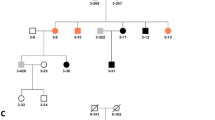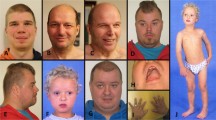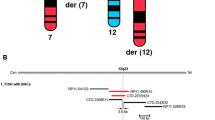Abstract
Defects in TRIM32 were reported in limb-girdle muscular dystrophy type 2H (LGMD2H), sarcotubular myopathies (STM) and in Bardet-Biedl syndrome. Few cases have been described to date in LGMD2H/STM, but this gene is not systematically analysed because of the absence of specific signs and difficulties in protein analysis. By using high-throughput variants screening techniques, we identified variants in TRIM32 in two patients presenting nonspecific LGMD. We report the first case of total inactivation by homozygous deletion of the entire TRIM32 gene. Of interest, the deletion removes part of the ASTN2 gene, a large gene in which TRIM32 is nested. Despite the total TRIM32 gene inactivation, the patient does not present a more severe phenotype. However, he developed a mild progressive cognitive impairment that may be related to the loss of function of ASTN2 because association between ASTN2 heterozygous deletions and neurobehavioral disorders was previously reported. Regarding genomic characteristics at breakpoint of the deleted regions of TRIM32, we found a high density of repeated elements, suggesting a possible hotspot. These observations illustrate the importance of high-throughput technologies for identifying molecular defects in LGMD, confirm that total loss of function of TRIM32 is not associated with a specific phenotype and that TRIM32/ASTN2 inactivation could be associated with cognitive impairment.
Similar content being viewed by others
Log in or create a free account to read this content
Gain free access to this article, as well as selected content from this journal and more on nature.com
or
References
Frosk P, Weiler T, Nylen E et al: Limb-girdle muscular dystrophy type 2H associated with mutation in TRIM32, a putative E3-ubiquitin-ligase gene. Am J Hum Genet 2002; 70: 663–672.
Schoser BG, Frosk P, Engel AG, Klutzny U, Lochmuller H, Wrogemann K : Commonality of TRIM32 mutation in causing sarcotubular myopathy and LGMD2H. Ann Neurol 2005; 57: 591–595.
Shokeir MH, Kobrinsky NL : Autosomal recessive muscular dystrophy in Manitoba Hutterites. Clin Genet 1976; 9: 197–202.
Shokeir MH, Rozdilsky B : Muscular dystrophy in Saskatchewan Hutterites. Am J Med Genet 1985; 22: 487–493.
Weiler T, Greenberg CR, Nylen E et al: Limb girdle muscular dystrophy in Manitoba Hutterites does not map to any of the known LGMD loci. Am J Med Genet 1997; 72: 363–368.
Jerusalem F, Engel AG, Gomez MR : Sarcotubular myopathy. A newly recognized, benign, congenital, familial muscle disease. Neurology 1973; 23: 897–906.
Reymond A, Meroni G, Fantozzi A et al: The tripartite motif family identifies cell compartments. EMBO J 2001; 20: 2140–2151.
Joazeiro CA, Weissman AM : RING finger proteins: mediators of ubiquitin ligase activity. Cell 2000; 102: 549–552.
Saccone V, Palmieri M, Passamano L et al: Mutations that impair interaction properties of TRIM32 associated with limb-girdle muscular dystrophy 2H. Hum Mutat 2008; 29: 240–247.
Kudryashova E, Kudryashov D, Kramerova I, Spencer MJ : Trim32 is a ubiquitin ligase mutated in limb girdle muscular dystrophy type 2H that binds to skeletal muscle myosin and ubiquitinates actin. J Mol Biol 2005; 354: 413–424.
Wilson PM, Fryer RH, Fang Y, Hatten ME : Astn2, a novel member of the astrotactin gene family, regulates the trafficking of ASTN1 during glial-guided neuronal migration. J Neurosci 2010; 30: 8529–8540.
Wang KS, Liu XF, Aragam N : A genome-wide meta-analysis identifies novel loci associated with schizophrenia and bipolar disorder. Schizophr Res 2010; 124: 192–199.
Lionel AC, Tammimies K, Vaags AK et al: Disruption of the ASTN2/TRIM32 locus at 9q33.1 is a risk factor in males for autism spectrum disorders, ADHD and other neurodevelopmental phenotypes. Hum Mol Genet 2014; 23: 2752–2768.
Bartoli M, Negre P, Wein N et al: Validation of comparative genomic hybridization arrays for the detection of genomic rearrangements of the calpain-3 and dysferlin genes. Clin Genet 2012; 81: 99–101.
Neri M, Selvatici R, Scotton C et al: A patient with limb girdle muscular dystrophy carries a TRIM32 deletion, detected by a novel CGH array, in compound heterozygosis with a nonsense mutation. Neuromuscul Disord 2013; 23: 478–482.
Lai W, Choudhary V, Park PJ : CGHweb: a tool for comparing DNA copy number segmentations from multiple algorithms. Bioinformatics 2008; 24: 1014–1015.
Vasson A, Leroux C, Orhant L et al: Cutom oligonucleotide array-based CGH: a reliable diagnostic tool for detection of exonic copy-number changes in multiple targeted genes. Eur J Human Genet 2013; 21: 977–987
Cossee M, Lagier-Tourenne C, Seguela C et al: Use of SNP array analysis to identify a novel TRIM32 mutation in limb-girdle muscular dystrophy type 2H. Neuromuscul Disord 2009; 19: 255–260.
Borg K, Stucka R, Locke M et al: Intragenic deletion of TRIM32 in compound heterozygotes with sarcotubular myopathy/LGMD2H. Hum Mutat 2009; 30: E831–E844.
Sato T, Okumura F, Iguchi A, Ariga T, Hatakeyama S : TRIM32 promotes retinoic acid receptor alpha-mediated differentiation in human promyelogenous leukemic cell line HL60. Biochem Biophys Res Commun 2012; 417: 594–600.
Hillje AL, Worlitzer MM, Palm T, Schwamborn JC : Neural stem cells maintain their stemness through protein kinase C zeta-mediated inhibition of TRIM32. Stem Cells 2011; 29: 1437–1447.
Gonzalez-Cano L, Hillje AL, Fuertes-Alvarez S et al: Regulatory feedback loop between TP73 and TRIM32. Cell Death Dis 2013; 4: e704.
Hillje AL, Pavlou MA, Beckmann E et al: TRIM32-dependent transcription in adult neural progenitor cells regulates neuronal differentiation. Cell Death Dis 2013; 4: e976.
Acknowledgements
This work was supported by the NMD-Chip project from the European Commission under its seventh framework program (FP7) under the call for ‘High throughput molecular diagnostics in individual patients for genetic diseases with heterogeneous clinical presentation’, N° HEALTH-F5-2008-223026. We thank the Post-Genomic Platform Pitié-Salpêtrière (P3S), Paris, France, for performing MPS.
Author information
Authors and Affiliations
Corresponding author
Ethics declarations
Competing interests
The authors declare no conflict of interest.
Rights and permissions
About this article
Cite this article
Nectoux, J., de Cid, R., Baulande, S. et al. Detection of TRIM32 deletions in LGMD patients analyzed by a combined strategy of CGH array and massively parallel sequencing. Eur J Hum Genet 23, 929–934 (2015). https://doi.org/10.1038/ejhg.2014.223
Received:
Revised:
Accepted:
Published:
Issue date:
DOI: https://doi.org/10.1038/ejhg.2014.223
This article is cited by
-
TRIM32 biallelic defects cause limb-girdle muscular dystrophy R8: identification of two novel mutations and investigation of genotype–phenotype correlation
Skeletal Muscle (2023)
-
Altered myogenesis and premature senescence underlie human TRIM32-related myopathy
Acta Neuropathologica Communications (2019)
-
Thin is required for cell death in the Drosophila abdominal muscles by targeting DIAP1
Cell Death & Disease (2018)



